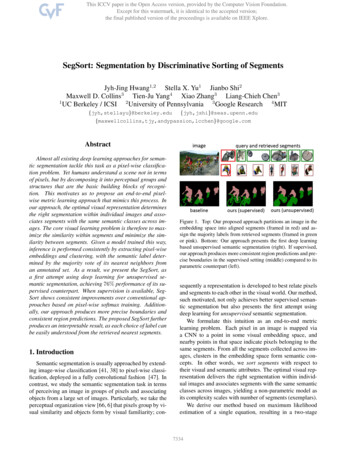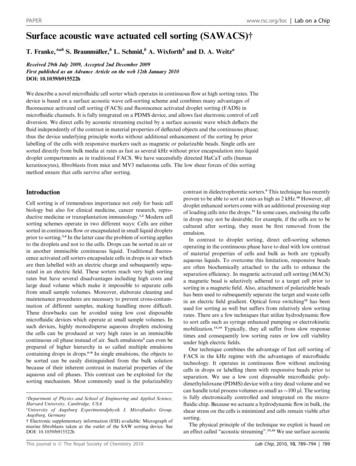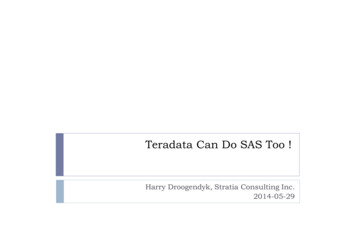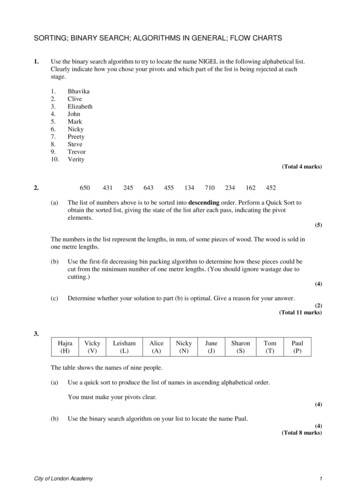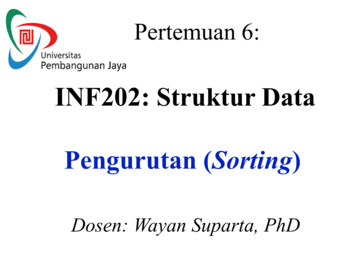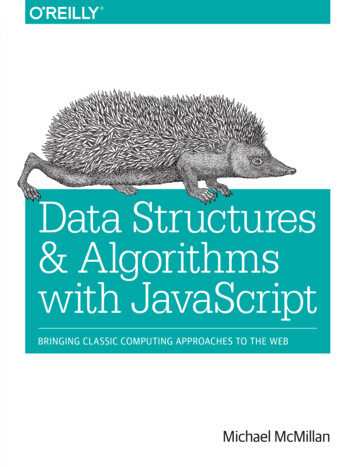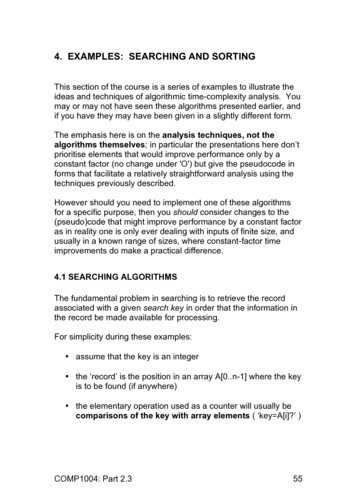
Transcription
4. EXAMPLES: SEARCHING AND SORTINGThis section of the course is a series of examples to illustrate theideas and techniques of algorithmic time-complexity analysis. Youmay or may not have seen these algorithms presented earlier, andif you have they may have been given in a slightly different form.The emphasis here is on the analysis techniques, not thealgorithms themselves; in particular the presentations here don’tprioritise elements that would improve performance only by aconstant factor (no change under 'O') but give the pseudocode informs that facilitate a relatively straightforward analysis using thetechniques previously described.However should you need to implement one of these algorithmsfor a specific purpose, then you should consider changes to the(pseudo)code that might improve performance by a constant factoras in reality one is only ever dealing with inputs of finite size, andusually in a known range of sizes, where constant-factor timeimprovements do make a practical difference.4.1 SEARCHING ALGORITHMSThe fundamental problem in searching is to retrieve the recordassociated with a given search key in order that the information inthe record be made available for processing.For simplicity during these examples: assume that the key is an integer the ‘record’ is the position in an array A[0.n-1] where the keyis to be found (if anywhere) the elementary operation used as a counter will usually becomparisons of the key with array elements ( ‘key A[i]?’ )COMP1004: Part 2.355
The simplest form of search to consider is sequential search inan unordered array:ALGORITHM SequentialSearch ( key, A[0.n-1] )// Sequential search with the search key as a sentinel// Output is the index of the first element in A[0.n-1] whose// value is equal to the key or -1 otherwiseA[n] key(to ensure termination if key isnowhere in array positions 0.n-1)i 0while A[i] key doi i 1if i nreturn i(found it at position i)elsereturn -1(i n, record not found)SequentialSearch can easily be seen to be O(n) in both worst(when the key isn’t in the array) and average cases.In the case of unsuccessful search there are n 1 passes throughthe loop (key compared to everything i 0.n, test succeeds only inthe dummy position n).In the case of successful search, the key may be found in any oneof n positions i 0.n-1 with equal probability. If the key is found inthe ith position, i 1 comparisons will have been made. Thus, theaverage number of comparisons for a successful search is1 n!11 n1(i 1) "i (n 1)"n i 0n i 1 2SequentialSearch can be made more efficient if the array is sortedsince a search can then be terminated unsuccessfully when anelement larger than the search key is found:COMP1004: Part 2.356
ALGORITHM SortedSequentialSearch ( key, A[0.n-1] )// Sequential search of a sorted array// Output is the index of the first element in A[0.n-1] whose// value is equal to the key or -1 otherwiseA[n] large value(to ensure termination if key is largerthan anything in array positions 0.n-1)i 0while A[i] key doi i 1if A[i] keyreturn i(found it)elsereturn -1 (A[i] is larger, no point in further searching aseverything to the right of it will be larger too)For successful search, the situation is as before, requiring ½(n 1)passes through the 'while' loop on average.An unsuccessful search is equally likely to be terminated at thesentinel position n or at positions i 0.n-1. Thus the averagenumber of key comparisons is1 n1 n 11(i 1) 1 i 1 (n 2) 1!!n 1 i 0n 1 i 12A[i] key?which is just over half the cost of unsuccessful search in anunsorted array.There are various heuristic techniques which can be used to speedup sequential search algorithms. For example, the most frequentlyaccessed records can be stored towards the beginning of the list,or if information about the relative frequency of access is notavailable this optimal arrangement can be approximated bymoving a record to the beginning of the list each time it isaccessed. However none of these techniques will improve theefficiency of the search procedure beyond O(n).COMP1004: Part 2.357
BINARY SEARCHWe assume that the array A is sorted by key into increasing orderand at each recursive call look for the key in either the first or thesecond half of the array. To find out which is the appropriate halfwe compare the key with the middle element.ALGORITHM BinarySearch ( key, A[b t] )// Recursive implementation of binary search,// called initially (for array A[0.n-1]) with b 0, t n-1// Output is the index of the first element in A whose// value is equal to the key or -1 otherwiseif b t (one element left)if key A[b] (key found at position b)return belse(key not found)return -1elsem !"(b t) / 2# ('middle' element, using integer division)if key A[m] thenBinarySearch( key, A[b m] )(look in the first half of the array)elseBinarySearch( key, A[m 1 t] );(look in the second half)(A more efficient implementation would have a three-way branch,checking if key A[m] before making a recursive call, but it’s a bitharder to analyse.)In order to analyse this algorithm we will assume for simplicity thatthe array A contains n distinct elements and that the key is indeedamong them, with an equal probability of being found at each ofthe n locations.COMP1004: Part 2.358
Let B(n) be the cost ( number of comparisons) needed to find thekey in the n-element array A[0 n-1].B(1) 1(key A[0]?)B(n) 1 m/n B(m) (1-m/n) B(n-m)(key A[m]? )prob key isamongst firstm elementsprob key is amongstlast n-m elementsSuppose n 2k, k log2n. Then the array will be divided into twoequal halves (m 2k-1 n-m, m/n 1/2) so thatB(2k) 1 ½ B(2k-1) ½ B(2k-1) 1 B(2k-1) Bk Bk-1 1BkBk-1 B1BkBk B(2k)-Bk-1 1Bk-2 1 - B0 1- B0 kB(2k) B(20) k B(1) k B(n) 1 log2n B(n) O(log n n is a power of 2) B(n) O(log n)as log n satisfies 'smoothness'condition etc(In fact it can be shown that binary search is O(log n) for bothunsuccessful and successful search, for all possible orderings ofarray elements.)COMP1004: Part 2.359
4.2 SORTING ALGORITHMSRealistic sorting problems involve files of records containing keys,small parts of the records that are used to control the sort. Theobjective is to rearrange the records so the keys are orderedaccording to some well-defined rule, usually alphanumeric, order.We will just look at the sorting of arrays of integers, correspondingto the keys in a more realistic situation, and for simplicity (so all thearray elements are distinct) consider only sorting of permutationsof the integers 1 n within an array A[1.n].(There is no reason n-element arrays always have to be indexed0.n-1, indexing 1.n will allow the zeroth position to be used for abit of housekeeping in the cases of InsertionSort and in terms ofalgebra will in general save us some pain.)We will measure the cost of the sort in terms of the number ofcomparisons of array elements involved; these will beconsidered to have unit cost.InsertionSortThis method considers the elements A[2].A[n] one at a time,inserting A[i] into its proper place amongst the elementsA[1].A[i-1] whilst keeping these sorted.While it isn’t in general a very efficient method (it is in O(n2) whilecompetitor algorithms like MergeSort are in O(nlogn)) it can be agood choice if the array is already close-to-sorted and because it issimple to implement also if n is small.COMP1004: Part 2.360
ALGORITHM InsertionSort ( A[1 n] )A[0] large negative value(to ensure termination where anelement at position i is smaller thaneverything in positions 1.i-1)for i 2 to n doe A[i]j iwhile e A[j-1] dothis test is guaranteed to failwhen j 1, so algorithmwill always terminateA[j] A[j-1]j j-1A[j] eNote that if the input is an ordered array the while loop is alwaysfalse at the outset and so only n-1 comparison operations areperformed. InsertionSort can thus be very efficient for close-tosorted arrays (see later discussion of its use within QuickSort).Worst caseThis corresponds to the input being an array in reverse order.In this case we have to compare e with A[i-1], A[i-2], , A[0](for which last value the test will always fail) before leaving the'while' loop, a total of i comparison operations.nn1i 2i 1i 1I(n) i i i n(n 1) 12So in the worst case InsertionSort O(n2).COMP1004: Part 2.361
Average caseSuppose (as usual) we are dealing with a permutation of theintegers 1 n and that each initial arrangement is equally likely.At the ith iteration of the outer loop element e A[i] is to be insertedinto its correct place among the elements A[1] . A[i-1]. If e A[1](worst case) there are i comparisons carried out, if A[1] e A[2](remember we are dealing with a permutation of 1 . n, so there areno repeated elements) there are i-1 comparisons, and so on.SitutationProbabilityA[i-1] eA[i-2] e A[i-1]A[i-3] e A[i-2] A[1] e A[2]e A[1]# Comparisons1/i1/i1/i 1/i1/i123 i-1iThe average number of comparisons for a given value of iis thus1 i1 i1c AV (i) k . (i 1) (i 1)i k 1i 22and thereforen1 n (n 1) 1 n 1 2 2 1 (n 1)(n 4)4 O(n2 )IAV (n) c AV (i) i 211Since IAV (n) I(n) (n 1) , InsertionSort -- on average -- is22twice as efficient for large arrays than in its worst case.But we are still O(n2) -- we would like to see a more significantimprovement.COMP1004: Part 2.362
MergeSortThe algorithm consists of separating the array A into two partswhose sizes are as nearly equal as possible, sorting these arraysby recursive calls, and then merging the solutions for each part(preserving the sorted order):ALGORITHM MergeSort( A[1.n] )if n 1 (something to sort)m !"(n / 2# copy A[1 m] to L(make a copy of the left half of A)copy A[m 1 n] to R (make a copy of the right half of A)Merge( MergeSort(L), MergeSort(R), A )where the procedure Merge merges into a single sorted array oflength (p q) two sub-arrays of length p, q that are already sorted:ALGORITHM Merge( A[1.p], B[1.q], C[1.p q] )// Merges two sorted arrays A and B into a single sorted array Ci 1; j 1; k 1while i p and j q doif A[i] B[j]C[k] A[i]; i i 1elseC[k] B[j]; j j 1k k 1if i p (possibly some elements left over in array B)copy B[j.q] to C[k.p q]else (possibly some elements left over in array A)copy A[i.p] to C[k.p q]COMP1004: Part 2.363
(Note that it’s possible to implement MergeSort without the needfor auxilliary arrays L,R, so saving space -- see eg Sedgwick’sbook ‘Algorithms’ for a discussion of this if you are interested.)Examples with n 8 (original array divided into two (now sorted)arrays of length 4)A [1,2,3,4], B [5,6,7,8]4 comparisons are carried out:A[i] ] B[j]? i j test result C array1 5?1 1 y[1]2 5?2 1 y[1,2]3 5?3 1 y[1,2,3]4 5?4 1 y[1,2,3,4]and copying in the rest (whole) of array B: C [1,2,3,4,5,6,7,8]A [1,3,5,7], B [2,4,6,8]7 comparisons are carried outA[i] ] B[j]? i j test result C array1 2?1 1 y[1]3 2?2 1 n[1,2]3 4?2 2 y[1,2,3]5 4?3 2 n[1,2,3,4]5 6?3 3 y[1,2,3,4,5]7 6?4 3 n[1,2,3,4,5,6]7 8?4 4 y[1,2,3,4,5,6,7]and copying in the rest of array B: C [1,2,3,4,5,6,7,8]The second is an instance of a worst case for Merge, in which thefirst array to become empty doesn't do so until there is only oneelement left in the non-empty one.The worst case for Merge is characterised by n-1 comparisons,which will be assumed in the following worst case analysis.COMP1004: Part 2.364
Assume also that the array size n is a power of 2 and let M(n) bethe worst case cost (in terms of the number of array elementcomparisons) to MergeSort an n-element array:M(1) 0M(n) 2M( n/2 ) n - 12 recursivecallssize ofrecursivecallscost of ‘merge’on L and RarraysNow we use similar techniques to those used for Strassen’smultiplication algorithm and binary search:Putting n 2k, Mk M(2k) :Mk 2 Mk-1 2k 1and settinggivesM k 2k. Nk2k Nk 2. 2k-1 Nk-1 2k 1 Nk Nk-1 1 1/2k (dividing by 2k)Setting up the usual 'ladder':Nk Nk-1 N1Nk- Nk-1 1 1/2k- Nk-2 1 1/2k-1 - N0 1 1/21- N0 k (1/21 . 1/2k)k Nk N0 k ! "i 1k#11& N k!1!%(0k2i 2 'x by 2 :M k 2kM 0 2kk 2 k 1 0, as nothing is done for a‘1-element array’ M(n) nxM(1) n log2n n 1 n log2n n 1 O(n log n n is a power of 2)COMP1004: Part 2.365
Since n log n is non-decreasing for n 1 (there is a turning pointbetween 0 and 1) and(2n) log (2n) 2n log 2 2n log n O(n log n)it can be concluded that for all nM(n) O(n log n)The number of key comparisons done by MergeSort in its worstcase, M(n) ! nlog2 n " n , is very close to the theoretical minimumthat must be done in the worst case by any sorting algorithmbased on comparison (see later).However it can nevertheless be bettered -- at least on average -by another well known divide and conquer algorithm:QuickSortIn outline:1. Choose one of the elements in the array to act as the pivot.2. Create a temporary array L to hold all elements smallerthan the pivot and another array R to hold all those whichare larger. Ideally the pivot should be chosen so that L andR are as nearly equal in size as possible -- ie the pivot is themedian -- but in a simple implementation we can just takethe pivot to be the first element in the array).3. Recursively call QuickSort on L and R sub-arrays.4. Append together the (sorted) left hand array L, the pivot,and the (sorted) right hand array R.COMP1004: Part 2.366
ALGORITHM QuickSort( A[1.n] )if n 1 (something to sort)l 0; r 0pivot A[1]for i 2 to n do(l,r will be the number of entries inthe left and right subarrays L,R)if A[i] pivotl l 1L[l] A[i]elser r 1R[r] A[i]Append( QuickSort(L), pivot, QuickSort(R), A )Append requires no comparisons:ALGORITHM Append( A[1.p], r, B[1.q], C )// Copies the p-element array A, element r, and the// q-element array B into a single array of length p q 1for i 1 to p doC[i] A[i]C[p 1] rfor i 1 to q doC[p i 1] B[i]QuickSort is in some sense the complement of MergeSort.In MergeSort creating the subinstances is easy, whereas inQuickSort it is more complex ('for' loop indexed by i).In MergeSort it is the putting together of the subinstances (theMerge procedure) that takes time, whereas the equivalent step inQuickSort is easy, just concatenating the two sorted sub-arrayswith the pivot to form one longer sorted array.COMP1004: Part 2.367
Complexity of QuickSortThe complexity of the QuickSort algorithm given above dependsvery much on the properties of its input. It is inefficient if ithappens systematically on most recursive calls that the L and Rsubinstances are severely imbalanced. In the worst case analysisthat follows we will assume l 0 (the left-hand array is empty -- soin fact the array is already sorted) on all such calls.Worst caseLet Q(n) be the worst case cost (number of array elementcomparisons) of QuickSorting an n-element array:Q(0) 0 (no comparisons when the array is defined empty)Q(n) (n-1) Q(l) Q(r)‘A[i] pivot?’for i 2 nrecursive callson L,R arraysIn the worst case scenario we are consideringQ(l) Q(0) 0 (left sub-array is empty)Q(r) Q(n-1)ThenQ(n) Q(n-1) n-1SoQ(n) Q(n-1) Q(2) Q(1)Q(n)- Q(n-1) n-1- Q(n-2) n-2 - Q(1) 1- Q(0) 0- Q(0) n (i 1)i 1nn11Q(n) i 1 n(n 1) n n(n 1)i 1i 122COMP1004: Part 2.368
So in the worst case QuickSort is O(n2).This highlights a weakness of worst case analysis sinceempirically QuickSort turns out to be one of the most efficientsorting algorithms known.We found that on average InsertionSort took about half the timethat would be expected in its worst case. We need to look at thebehaviour of QuickSort on average also.Average caseAs in the case of InsertionSort we will interpret the 'average cost'to mean the sum of the costs for all possible cases multipliedby the probability of occurrence of each case.In this case we have n equiprobable situations defined by thenumbers of elements l, r transferred to each of the left, rightsubarrays:l01 n-2n-1rn-1n-2 10lr1 nQ AV (n) n 1 (Q AV (i 1) Q AV (n i))n i 1 1 Q (0) Q AV (1) . Q AV (n 1) n 1 AV n Q AV (n 1) Q AV (n 2) . Q AV (0) COMP1004: Part 2.369
2 n Q AV (i 1)n i 1Q AV (n) n 1 (1)Letting n n-1 in (1) givesQ AV (n 1) n 2 2 n 1 Q AV (i 1)n 1 i 1(2)n x (1) – (n-1) x (2) nQ AV (n) (n 1)Q AV (n 1) n(n 1) (n 1)(n 2) 2Q AV (n 1)or re-arranging the terms to have all occurrences of Q AV (n) on theleft hand side, all occurrences of Q AV (n 1) on the right hand side:nQ AV (n) (n 1)Q AV (n 1) 2(n 1)n 1(n 1)Q AV (n) Q AV (n 1) 2nnn‘bn’( bi 1i 2 3nn 1 . n 1 )1 2n 1 nto get rid of multiplyingcoefficient substituteQAV(n) (n 1)S(n) (n 1)S(n) (n 1)(n 1) n/ S(n 1) 2n/nDivide by (n 1):n 1n(n 1)42 S(n 1) n 1 nS(n) S(n 1) 2COMP1004: Part 2.370
So42 n 1 n42 S(n 1) S(n 2) n n 14 2 S(1) S(0) 2 1S(n) S(n 1) n11S(n) S(0) 4 2 i 1 i 1i 1 inn11 2 i 1 i 1i 1 in S(n) S(0) 4 These summations are a problem. There is no explicit formula forsums of these forms, they need to be estimated.11is non-increasing and that ! isx 1xconversely non-decreasing, and using the results on pp.19-20 forapproximating a sum by an integral, it can be seen thatNoting that the functionnn 1"11%S(n) S(0) 4 (dx 2 ( ! ' dx0 x 11 # x&n S(0) 4 "0n 111dx ! 2 " dxx 11 x S(0) 4 ln(n 1) – 2 ln(n 1)(‘ln’ is loge, where the number e 2.718.) S(0) 2 ln(n 1)COMP1004: Part 2.371
This is the solution for the new function S(n).To get the solution for the original function Q(n), the number ofcomparisons performed by QuickSort on an input of size n,multiply by (n 1) and use the fact that QAV(0) S(0) 0 to give theupper-bound result (all we need for a ‘O’ estimation of time cost):QAV(n) 2(n 1)ln(n 1)For large n, for which n 1 n and hence ln(n 1) ln nQAV(n 2n ln nand soQAV(n) O(n log n)The above implementation of QuickSort, which performs very wellfor randomly ordered files, is a good general-purpose sort.However it is possible to improve the basic algorithm both withregard to speeding up the average case and making it less likelythat bad cases occur.The two main ways in which QuickSort can be speeded up (by aconstant factor) are to use a different sorting algorithm for smallsubfiles and to choose the pivot element more cleverly so thatworst cases are less likely to consistently occur.COMP1004: Part 2.372
Small subfilesThe QuickSort algorithm as formulated above just tests whetherthe array to be sorted has more than one element.It can be made much more efficient if a simpler sorting algorithm isused on subfiles smaller than a certain size, say M elements.For example the test could be changed toif (number of elements in A) MInsertionSort(A)elseQuickSort(A)where InsertionSort is chosen because it was seen to be close tolinear on 'almost sorted' files (the partitioning process in QuickSortnecessarily delivers subfiles that are closer to the sorted state thanthe parent they were derived from).The optimal value of M depends on the implementation but itschoice is not critical; the modified algorithm above works about asfast for M in the range from about 5 to 25. The reduction inrunning time is on the order of 20% for most applications.COMP1004: Part 2.373
Choice of pivot elementIn the implementation above we arbitrarily chose the pivot elementto be A[1], though we noted the pivot should ideally be chosen tobe the median element in size so that the L and R arrays were asnearly equal in their number of members as possible. In the casethat the file to be sorted is in either ascending or descending orderthe choice of A[1] as the pivot leads to a cost O(n2).One way of avoiding this worst case would be to choose a randomelement from the array as the pivot, in which case the worst casewould happen with very small probability -- this is a simpleexample of a probabilistic algorithm in which randomness isused to achieve good performance almost always, regardless ofthe arrangement of the input.A more effective improvement however, and one which brings uscloser to the ideal of choosing the pivot to be the median, is to takethree elements from the array -- say from the beginning, middleand end -- then use the median of these as the partitioningelement. This median-of-three method makes the worst casemuch less likely to occur in any actual sort, since in order for thesort to take time in O(n2) two out of the three elements examinedmust be among the largest or smallest elements in the array, andthis must happen consistently throughout most of the partitions.In combination with a cutoff for small subfiles, the median-of-threecan improve the performance of QuickSort by about 25%.COMP1004: Part 2.374
4.1 SEARCHING ALGORITHMS The fundamental problem in searching is to retrieve the record associated with a given search key in order that the information in the record be made available for processing. For simplicity during these examples: assume that the key is an integer the ‘re

